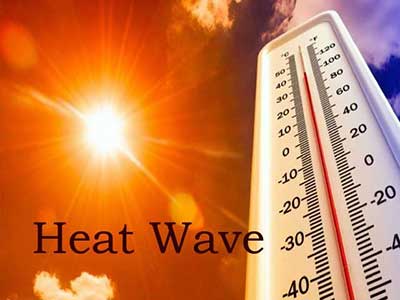Relevance: GS-3: Disaster and disaster management, Science and Technology- developments and their applications and effects in everyday life.
Key Phrases: Heatwave, Cool roofs programme , heat action plan, Indian Meteorological Department, Heat Stoke, Heat Exhaustion, Heat Cramps.
Context
- Community outreach and a roofing programme have saved thousands of lives across the country.
Background
- It’s been twelve years since Ahmedabad experienced a devastating heatwave. In one lethal week in May 2010, temperatures surpassed 48°C and 800 people died.
- Authorities advised people to stay indoors during the hottest part of the day as hospitals were overloaded. Bats and birds dropped dead from the trees they roosted in.
- Conditions were exacerbated by climate change and a slow-moving cyclone.
Heat Wave
A Heat Wave is a period of abnormally high temperatures, more than the normal maximum temperature that occurs during the summer season in the North-Western parts of India. Heat Waves typically occur between March and June, and in some rare cases even extend till July. The extreme temperatures and resultant atmospheric conditions adversely affect people living in these regions as they cause physiological stress, sometimes resulting in death.
The Indian Meteorological Department (IMD) has given the following criteria for Heat Waves :
- Heat Wave need not be considered till maximum temperature of a station reaches atleast 40°C for Plains and atleast 30°C for Hilly regions
- Based on Departure from Normal
- Heat Wave: Departure from normal is 4.5°C to 6.4°C
- Severe Heat Wave: Departure from normal is >6.4°C
- Based on Actual Maximum Temperature
- Heat Wave: When actual maximum temperature ≥45° C
- Severe Heat Wave: When actual maximum temperature ≥47°C
- When actual maximum temperature remains 45°C or more irrespective of normal maximum temperature, heat waves should be declared.
Health Impacts of Heat Waves:
- The health impacts of Heat Waves typically involve
dehydration, heat cramps, heat exhaustion and/or heat stroke. The signs
and symptoms are as follows:
- Heat Cramps: Ederna (swelling) and Syncope (Fainting) generally accompanied by fever below 39°C i.e.102°F.
- Heat Exhaustion: Fatigue, weakness, dizziness, headache, nausea, vomiting, muscle cramps and sweating.
- Heat Stoke: Body temperatures of 40°C i.e. 104°F or more along with delirium. seizures or coma. This is a potential fatal condition.
Heat Action Plan: Cool roofs
- Since that tragic week, the Ahmedabad Municipal Corporation partnered with the India Institute of Public Health-Gandhinagar (IIPH-G) and the US Natural Resources Defense Council (NRDC) to develop India’s first heat action plan. An estimated 1,190 deaths have been avoided each year since its launch in 2013.
- The heat action plan builds resilience to extreme heat events through public awareness and community outreach, inter-agency coordination to enable an early warning system, capacity building among healthcare professionals, and promoting adaptive measures to reduce heat exposure.
- People living in slums are particularly vulnerable — many homes are far from optimal, with few options for cooling and highly compromised living conditions.
Cool roofs programme
- An important component of the heat action plan includes ‘cool roofs’ — coatings or materials that reflect sunlight and absorb less heat.
- Depending on the setting, cool roofs can help keep indoor temperatures lower by 2 to 5°C compared with traditional roofs that are often made from corrugated tin or sheets of asbestos.
- Building on the back of a successful pilot in 2017, in 2020, Ahmedabad announced a cool roofs program for more than 15,000 slum roofs and 1,000 government buildings as part of its heat action plan.
- The focus of the larger roll-out is on slum households and local government buildings. The pilot in 2017 focused on community awareness through pamphlets, hoardings and communication materials to increase local knowledge on what cool roofs are, how they can help keep indoor temperatures lower, and what materials can be used to convert to a cool roof.
- Cool roofs are also popping up in other parts of the country. In 2020, NRDC and Mahila Housing Trust painted the roofs of selected slum households with solar reflective paint in four cities — Jodhpur, Bhopal, Surat, and Ahmedabad.
- The households were selected based on the household’s electricity usage, type of roof (tin or cement), exposure to sunlight, and the number of household members sharing the space. The program across the four cities painted more than 460 roofs and provided information on solar reflective paint to 13,587 households and 67,935 individuals.
Conclusion
- Extreme heat is not merely an inconvenience; it can be deadly. Nearly half a billion Indians live in rapidly urbanising cities, with skyrocketing development that converts open space into paved, heat-trapping roofs and roads.
- Fuelled by climate change, many Indian states will experience ever-more deadly heatwaves.
- Initiatives such as heat action plans and community outreach on reducing exposure to extreme heat have proven to be effective in enhancing heat resilience.
- Cool roofs and other adaptations to building design can provide simple and effective solutions to increasing heat in urban areas.
Sources : The Hindu BL
Mains Question:
Q. What is heat wave ? How climate change is contributing to its rise ? (words 250).








